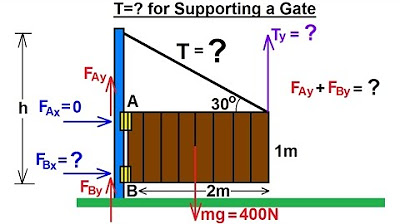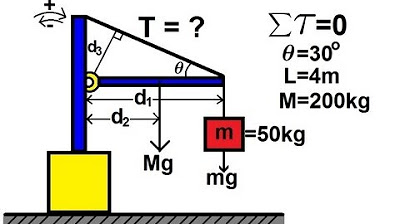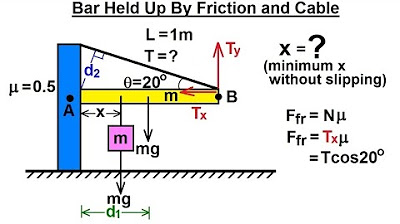Physics 15 Torque (12 of 27) Example 2: Forces=? Tension=?
TLDRThe video script presents a detailed explanation of a physics problem involving a beam, a hinge, a person, and a cable. The setup consists of a beam suspended by a hinge on one side and a cable on the other, with a person standing two meters from the left post. The beam is five meters long, with a mass of 200 kilograms, and the person has a mass of 60 kilograms. The cable makes a 30-degree angle with the horizontal. The goal is to find the tension in the cable and the vertical force on the hinge. Using the principle of equilibrium and torque analysis around two different pivot points, the video demonstrates how to calculate the unknown forces. The tension in the cable is found to be 2430 Newtons, and the vertical force on the hinge is calculated to be 1333 Newtons. The explanation emphasizes the importance of selecting the correct pivot points for solving for unknown forces in such problems.
Takeaways
- 📐 **Pivot Point Selection**: The process begins by selecting a pivot point to analyze the system in equilibrium.
- ⚖️ **Torque Equilibrium**: The sum of all torques about the chosen pivot point must equal zero for the system to be in equilibrium.
- 🧵 **Tension Calculation**: To find the tension in the cable, the script uses the torques created by the weight of the person and the beam, as well as the tension force.
- 📏 **Distance Measurements**: Key distances from the pivot point to the lines of action of forces are used to calculate torques.
- 🔢 **Forces and Masses**: The weight of the person (60 kg) and the beam (200 kg) are essential for calculating the forces involved.
- 🤸♂️ **Moments and Torques**: The moments of forces (torques) are calculated by multiplying the weight (force) by the perpendicular distance from the pivot.
- 📉 **Negative Torque**: The weight of the person and the beam create negative torques as they tend to rotate clockwise about the pivot.
- ➗ **Solving for Tension**: The tension in the cable is found by solving the equilibrium equation, which involves the weights and the distance to the pivot point.
- 🔍 **Angle Consideration**: A 30-degree angle is used to calculate the perpendicular distance from the line of action of the tension force to the pivot point.
- 🎛️ **Supporting Force Calculation**: After finding the tension, the script shifts the pivot point to find the vertical force on the hinge supporting the beam.
- 📍 **New Pivot Point**: A different pivot point is selected to calculate the unknown force in the Y-direction acting on the beam.
Q & A
What is the main objective of the problem described in the transcript?
-The main objective is to find the tension in the cable and the vertical force on the hinge supporting the beam.
What is the mass of the person standing on the beam?
-The mass of the person standing on the beam is 60 kilograms.
What is the mass of the beam itself?
-The mass of the beam is 200 kilograms.
How far is the person standing from the left post?
-The person is standing 2 meters away from the left post.
What is the length of the beam?
-The length of the beam is 5 meters.
What is the angle made by the cable relative to the horizontal?
-The cable makes an angle of 30 degrees relative to the horizontal.
What is the method used to find the tension in the cable?
-The method used is to apply the principle of equilibrium, stating that the sum of all torques about a chosen pivot point must be zero.
How is the distance D calculated in the problem?
-The distance D is calculated as the product of the beam's length (5 meters) and the sine of the 30-degree angle.
What is the calculated tension in the cable in Newtons?
-The calculated tension in the cable is 2430 Newtons.
What is the method used to find the vertical force on the hinge?
-The method involves shifting the pivot point to a new location and again applying the principle of equilibrium to find the unknown force.
What is the calculated vertical force on the hinge in Newtons?
-The calculated vertical force on the hinge is 1333 Newtons.
Why is it important to choose the correct pivot point in these calculations?
-Choosing the correct pivot point is important because it allows for the accurate application of the principle of moments (torques) to solve for unknown forces in the system.
What is the significance of considering the direction of forces when calculating torques?
-The direction of forces is significant because it determines whether a torque will cause a clockwise or counterclockwise rotation about the pivot point, which affects the sign (positive or negative) of the torque in the calculations.
Outlines
🔍 Analyzing Tension and Support Force in a Beam System
The first paragraph introduces a mechanical problem involving a beam system with a person and a weight (masseter) suspended from it. The system is in equilibrium, with a hinge on one side and a cable on the other. The task is to find the tension in the cable and the vertical force on the hinge. To do this, the narrator selects a pivot point (Point A) and applies the principle of moments, stating that the sum of torques around this point must be zero. The forces considered are the weight of the person, the weight of the beam (masseter), and the tension in the cable. The narrator calculates the distances from the forces' lines of action to the pivot point and uses trigonometry to find the perpendicular distance (D) from the tension force's line of action to the pivot. After substituting the values and solving the equation, the tension in the cable is found to be 2430 Newtons.
🧮 Calculating Vertical Support Force on the Hinge
The second paragraph continues the analysis by finding the vertical force on the hinge. The narrator shifts the pivot point to a new location (Point B) and again applies the principle of moments, stating the sum of torques around this new pivot must be zero. The forces considered now are the vertical components of the person's weight, the beam's weight, and the upward force exerted by the hinge. The narrator calculates the torques caused by these forces and sets up an equation to solve for the unknown vertical force (F sub y). After rearranging the equation and solving for F sub y, the force at the hinge in the Y direction is found to be 1333 Newtons. The paragraph concludes by emphasizing the method of selecting the correct pivot point to solve for unknown forces in such mechanical equilibrium problems.
Mindmap
Keywords
💡Lectern Line
💡Equilibrium
💡Torque
💡Pivot Point
💡Tension
💡Vertical Force
💡Hinge
💡Beam
💡Mass
💡Weight
💡Angle
Highlights
The problem involves finding the tension in a cable and the vertical force on a hinge supporting a beam.
A pivot point is chosen at Point A to analyze the torques in equilibrium.
The weight of a 60 kg person 2 meters from the pivot and a 200 kg beam's weight are considered as torques.
The tension in the cable causes a counter-clockwise motion and is a positive torque.
The perpendicular distance from the line of action of forces to the pivot point is crucial for torque calculation.
The length of the beam and the angle of the cable (30 degrees) are used to find the perpendicular distance (D).
The sine of 30 degrees is utilized to calculate D, which is opposite the 30-degree angle.
The equation for torque equilibrium is set to zero, considering all forces acting at Point A.
The tension in the cable is calculated to be 2430 Newtons using the equilibrium equation.
A new pivot point B is chosen to find the supporting force by the hinge in the vertical direction.
The sum of torques acting on Point B is also set to zero for equilibrium.
The weights of the person and the beam contribute to positive torques around Point B.
The force of the post or hinge pushing up on the beam is considered a negative torque.
The vertical force on the hinge (F_y) is isolated and calculated using the torque equation.
The force at the hinge in the Y direction is found to be 1333 Newtons.
The method involves selecting the correct pivot point to solve for unknown tensions and forces.
The mathematical approach is emphasized for its ease in finding unknowns in similar problems.
Transcripts
Browse More Related Video

Physics 15 Torque (5 of 27) Tension=? Supporting a Gate

Physics 15 Torque (3 of 27) Tension=? in the Cable

Physics 15 Torque (19 of 25) More Examples: 1 T=? of Cable Holding Fish

Physics 15 Torque Example 1 (1 of 7) Mass on Rod and Cable

Physics 15 Torque Example 2 (2 of 7) Mass on Rod and Cable

Physics 15 Torque (4 of 27) Bar Held Up by Friction
5.0 / 5 (0 votes)
Thanks for rating: